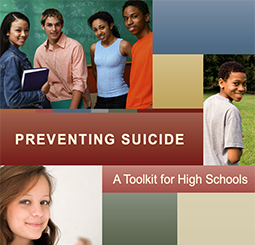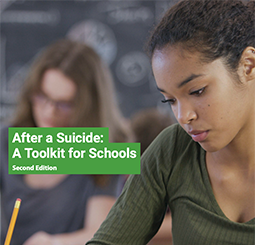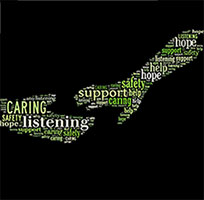Intervention Guidelines
The guide below is to give school administrators an idea of the steps that should be taken with regards to suicide prevention and suicide risk interventions, however this guide should not take the place of a robust suicide prevention program, or suicide risk assessment conducted by a school employed mental health professional. The questions included in these documents are sample questions that could be asked, but again, these are samples and not inclusive of all questions that should be asked, and do not replace the training necessary in conducting such risk assessments.
Download PDFIntervening with Suicidal Youth*
Instructions for Crisis Team
- Supervise the student and assign a designated reporter. Ideally, the chain of supervision begins with the perceptive, trained gatekeeper who escorts the student directly to the attention of a school crisis team member who will serve as the designated reporter. This is typically a school psychologist, counselor, social worker, or nurse who has been trained to conduct suicide risk assessments. Under no circumstance should the student be allowed to leave school or be alone (even in the restroom) until a risk assessment has been completed and a plan has been generated. It may be appropriate to solicit the aid of collaborators to monitor the child while the crisis team member seeks a phone in private.
- Collaborate with administration or crisis team personnel. Many potentially difficult decisions will have to be made; having the support of an administrator and one other staff member (perhaps the school psychologist, nurse, counselor, or social worker) is both reassuring and prudent. (consider having collaboration part of your policy)
- Warn parents or protective services. Whether a child/adolescent is assessed to be low, moderate, or high risk, parents or protective services must be notified in a timely fashion by the designated reporter. Never tell a parent there is no risk at all.
- Provide resources to parents. Provide parents with school-site and local mental health resources as appropriate.
- Utilize law enforcement when appropriate. All school crisis teams should include a representative from local law enforcement. If a student resists, becomes combative or attempts to flee, law enforcement can be of vital assistance. In some cases, they can assume responsibility for securing a 72-hour hold which will place the youth in protective custody up to three days for psychiatric observation.
Assessing Risk in Suicidal Students
Questions to ask students:
- Have you thought about suicide? Thoughts or threats alone, whether direct or indirect, may indicate LOW risk.
- Have you tried to hurt yourself before? Previous attempts or repetitive self-injury may indicate MODERATE risk. If the student answers “yes” you must ask a follow up question regarding if they have attempted self-injury or suicide.
- Do you have a plan to kill yourself now? The more involved the planning, the greater the risk. If you ask if there is a plan to harm themselves, if the student answers in the affirmative, you still do not have enough information., so you must specifically ask about suicide.
- What method are you planning to use and do you have access to the means? These questions would indicate HIGH risk.
Questions to ask parents, teachers, staff:
- What warning signs(s) initiated the referral?
- Has the student demonstrated abrupt changes in behaviors?
- What is the support system surrounding this child? The more the student feels isolated and alone, the greater the risk.
- Is there a history of mental illness (depression, alcohol and substance abuse, conduct or anxiety disorder, co-morbidity)?
- Is there a history of recent loss, trauma, or victimization?
Questions, Indicators, Levels of Risk and Interventions
LOW RISK (Ideation):
- Sample student question: Have you ever thought about suicide (harming yourself)?
- Other Indicators: current or recent thoughts of suicide; signs of depression; direct or indirect threats (including on social media); sudden changes in personality, friends, and behaviors; evidence of self-harm in art or written work; dark internet websites and chat.
- Actions: Reassure and supervise the student; warn parent; assist in connecting with school and community resources; suicide-proof environments; mobilize a support system; develop a safety plan that identifies caring adults, appropriate communication and coping skills, and resource numbers.
- Document all actions.
MODERATE RISK (Current ideation and previous behaviors):
- Sample student question: Have you ever tried to kill yourself before? (But consider asking about self-injury as well).
- Other Indicators: previous suicide attempts; recent mental health hospitalizations; recent trauma (losses, victimization); recent medications for mood disorders; alcohol and substance addiction; running into traffic or jumping from high places; repetitive self-injury.
- Actions: See high risk.
- Document all actions.
HIGH RISK (Current plan and access to method):
- Sample student question: Do you have a plan to kill (harm) yourself today?
- Other Indicators: current plan with method and access to means; finalizing arrangements; giving away prized possessions or written or emailed goodbye notes; refusal to agree to a safety plan.
-
Actions:
- Supervise student at all times (including restrooms).
-
Notify and hand off student ONLY to:
- Law enforcement.
- Psychiatric mobile responder.
- Parent or guardian who commits to seek an immediate mental health assessment. (Can use a police escort if needed).
- Document all actions.
- Prepare a safety and support plan.
- Prepare a re-entry plan. All students returning from mental health hospitalization should have a re-entry meeting where parents, school, and community mental health personnel make appropriate follow-up plans.
Toolkits

Teacher and Mental Health Professional Roles in Prevention

Preventing Suicide: A Toolkit for High Schools


Toolkit for Health Promotion and Suicide Prevention
This Toolkit, from the Health Care Alliance for Response to Adolescent Depression, assists schools with promoting mental health, intervening in a mental health crisis, and supporting members of a school community after a loss to suicide.
Guides and Toolkits
-
Resilience Guide for Parents & Teachers, American Psychological Association
Resilience Guide for Parents & Teachers provides introductory information on development of resilience in children from preschool to adult. This resource is available in English and Spanish.
-
California Department of Education, Supporting Resiliency in Schools
This website provides a list of helpful resources regarding resiliency and trauma for children.
Suicide Prevention Resources
Maintaining a Positive School Climate
-
Positive Behavior Interventions and Supports
This is the Technical Assistance Center on Positive Behavioral Interventions and Supports. This website provides information for school districts on school climate and universal, targeted, and intensive behavioral supports for students.
Suicide Awareness Activities
-
Know the Signs
Know the Signs is a California social marketing campaign emphasizing three key messages: “Know the signs. Find the words. Reach out.” This link takes you to resources and offers assistance to help increase knowledge of warning signs of suicide.
High School Clubs
-
National Alliance on Mental Illness On Campus (NAMI OC)
The National Alliance on Mental Illness is a mental health organization focused on building better lives for those affected by mental illness. NAMI OC high school clubs are student-led clubs that raise mental health awareness and reduce stigma through peer-led education and campus activities.
Mental Health Awareness
-
Each Mind Matters
Each Mind Matters is California’s mental health movement. This website includes resources and information to create your school’s campaign to raise awareness and reduce stigma associated with mental health disorders. This is important since many youth who experience suicidal thoughts also have a mental health issue.
Centers for Disease Control (CDC)
-
Preventing Suicide through Connectedness
The CDC Preventing Suicide through Connectedness resource assists schools with understanding the link between connectedness and suicide prevention.
Other Resources
-
Inclusive Anti-bullying Policies and Reduced Risk of Suicide Attempts in Lesbian and Gay Youth, Journal of Adolescent Health
This article examines the impact of anti-bullying policies that are inclusive of sexual orientation.
-
Resources and activities for children/youth and parents about internet safety
This website focuses on internet safety for schools and communities.
-
School-Wide Positive Behavior Support Resources to prevent Bullying
The Technical Assistance Center for Positive Behavior Interventions and Supports (PBIS) offers bullying prevention resources for schools.
-
Teaching Tolerance classroom activities and resources for schools
The Teaching Tolerance website offers diversity training and resources for schools.
-
The Youth Suicide Prevention School-Based Guide
A tool that provides a framework for schools to assess their existing or proposed suicide prevention efforts (through a series of checklists) and provides resources and information that school administrators can use to enhance or add to their existing program. Funded by the Institute of Child Health Policy at NOVA Southeastern University through a Florida Drug Free Communities Program Award.
-
Youth Suicide-Prevention Guidelines for California Schools
These guidelines are available to assist schools to develop and implement plans for youth suicide prevention, intervention, and aftermath. The guidelines blend information from a variety of expert sources and are intended to help school communities in their school planning and prevention efforts. Counseling, student support specialists, and local mental health specialists should be consulted for planning and implementing school plans or for individual student referrals regarding youth suicide.
-
NASSP – Promoting Mental Health in Middle Level and High Schools
This is a website resource from the National Association of Secondary School Principals.
-
American Foundation for Suicide Prevention
The American Foundation for Suicide Prevention is a website that provides resources and aid to those affected by suicide. This website has links specifically for educators.
-
Suicide Prevention Resource Center
The Suicide Prevention Resource Center website has tools and resources to assist educators in the prevention of suicide.
-
Coalition to Support Grieving Students
The Coalition to Support Grieving Students is a website that provides resources and training modules for educators to assist with supporting grieving students.
-
Didi Hirsch Mental Health Services
Didi Hirsch is committed to providing quality mental health and substance abuse services in communities where stigma and poverty limit access. Didi Hirsch provides resources and training in suicide prevention for educators and clinicians.
-
GLSEN
GLSEN (pronounced “glisten”) is a national education organization started by teachers dedicated to ensuring safe and affirming schools for LGBTQ+ students.
-
The Relationship Between Bullying and Suicide: What we Know and What it Means for Schools
This pamphlet from the CDC explains the relationship between bullying and suicide and provides information and resources for school personnel.
-
Asian American Suicide Prevention and Education
Provides educational flyers, brochures and information in English, Chinese, Korean, Japanese and Vietnamese.
-
Trevor Project
The Trevor Project is a leading national organization providing crisis intervention services to lesbian, gay, bisexual, transgender, queer and questioning youth under 25.
-
Welcomingschools.org
Welcomingschools.org is a professional development program providing training and resources to elementary school educators to embrace all families, create LGBTQ+ and gender inclusive schools, prevent bias-based bullying, and support transgender and non-binary students.